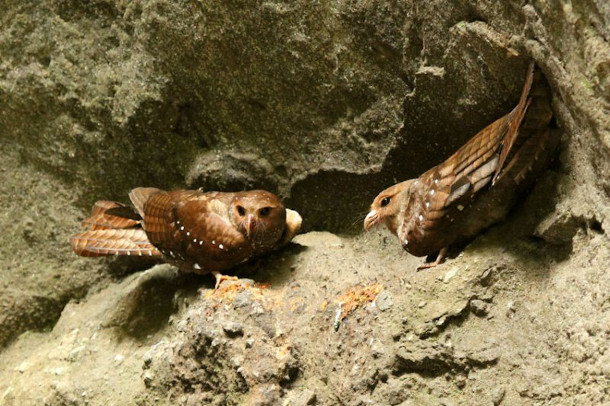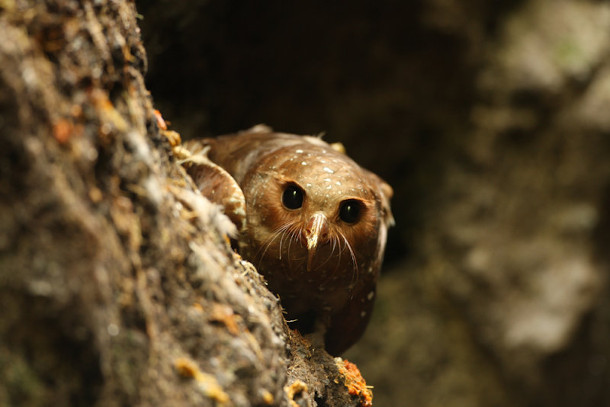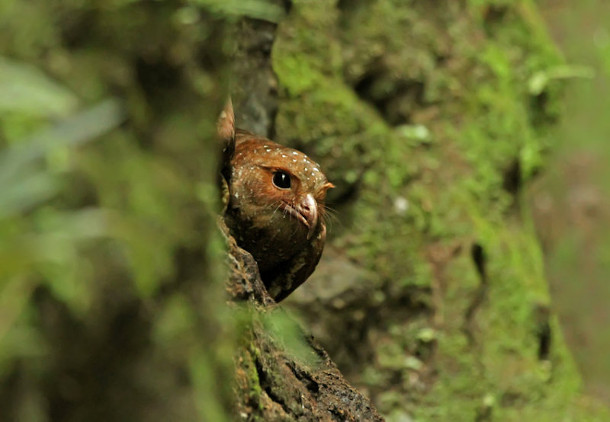BirdNote®: The Oilbird’s Lightless Life
Air Date: Week of January 8, 2021

Oilbirds have excellent night vision, due to having the highest density of rods of any known vertebrate. (Photo: Roger Alham)
Oilbirds live their whole lives in darkness, emerging from the South American caves where they live only at night. BirdNote®’s Ashley Ahearn shares how oilbirds use echolocation and night vision to forage, and how the bird got its unique name.
Transcript
BASCOMB: It’s Living on Earth, I’m Bobby Bascomb.
CURWOOD: And I’m Steve Curwood
[BIRDNOTE THEME]
CURWOOD: Birds have evolved in many surprising ways to adapt and thrive, from swimming penguins to hovering humming birds. Ashley Ahearn of Birdnote reports on a South America bird that shares an adaptation with bats.
BirdNote®
The Oilbird’s Lightless Life
[Calls of Oilbirds: http://macaulaylibrary.org/audio/4559]

Oilbirds roost in caves, but need to live near forests in order to obtain food. (Photo: Roger Alham)
These are the freakish snarls of the Oilbird, which spends its whole life in the dark. These birds live in caves in Trinidad and South America and fly out at night to search for food. The Oilbird is adapted to this lifestyle. It uses echolocation — like a bat — to find its way in the pitch-black of its cave. [Oilbird echolocation clicks and calls] And the birds have excellent night vision — rivaling that of an owl’s — to help them forage after dark. Fossils suggest that the Oilbird diverged from other bird families more than 50 million years ago. It has no close living relatives. [Oilbird echolocation clicks and calls] The Oilbird isn’t black, as its name might suggest. It’s actually a rich brown with large white spots. It has a hooked beak, like a hawk, but it’s not a meat-eater. The Oilbird lives on tree fruit, especially palm nuts and avocados, which it finds thanks to its keen sense of smell. This diet, rich in fat and oils, leads to plump chicks… and the name… Oilbird. In fact, humans used to boil down the birds to make oil.

Oilbirds’ favorite fruit is the fruit of the oil palm. These fruits can be collected and boiled down to extract their fat for use as fuel. (Photo: Tony Palliser)
[Calls of Oilbirds: http://macaulaylibrary.org/audio/4559]
###
Written by Bob Sundstrom
First set of bird sounds provided by The Macaulay Library of Natural Sounds at the Cornell Lab of Ornithology, Ithaca, New York: Oilbird calls [4559] recorded by David W Snow in Trinidad and Tobago's Arima Valley, in 1959.
Oilbird echolocation clicks and calls recorded by Andrew Spencer in Ecuador.
BirdNote's theme music was composed and played by Nancy Rumbel and John Kessler.
Producer: John Kessler
Executive Producer: Sallie Bodie
Editor: Ashley Ahearn
Associate Producer: Ellen Blackstone
Assistant Producer: Mark Bramhill
© 2015 BirdNote January 2015 / January 2020 Narrator: Ashley Ahearn
ID # oilbird-01-2015-01-27 oilbird-01b
https://www.birdnote.org/show/oilbirds-lightless-life
CURWOOD: For pictures navigate over to the Living on Earth website, LOE dot org
Links
Living on Earth wants to hear from you!
Living on Earth
62 Calef Highway, Suite 212
Lee, NH 03861
Telephone: 617-287-4121
E-mail: comments@loe.org
Newsletter [Click here]
Donate to Living on Earth!
Living on Earth is an independent media program and relies entirely on contributions from listeners and institutions supporting public service. Please donate now to preserve an independent environmental voice.
NewsletterLiving on Earth offers a weekly delivery of the show's rundown to your mailbox. Sign up for our newsletter today!
 Sailors For The Sea: Be the change you want to sea.
Sailors For The Sea: Be the change you want to sea.
 The Grantham Foundation for the Protection of the Environment: Committed to protecting and improving the health of the global environment.
The Grantham Foundation for the Protection of the Environment: Committed to protecting and improving the health of the global environment.
 Contribute to Living on Earth and receive, as our gift to you, an archival print of one of Mark Seth Lender's extraordinary wildlife photographs. Follow the link to see Mark's current collection of photographs.
Contribute to Living on Earth and receive, as our gift to you, an archival print of one of Mark Seth Lender's extraordinary wildlife photographs. Follow the link to see Mark's current collection of photographs.
 Buy a signed copy of Mark Seth Lender's book Smeagull the Seagull & support Living on Earth
Buy a signed copy of Mark Seth Lender's book Smeagull the Seagull & support Living on Earth

